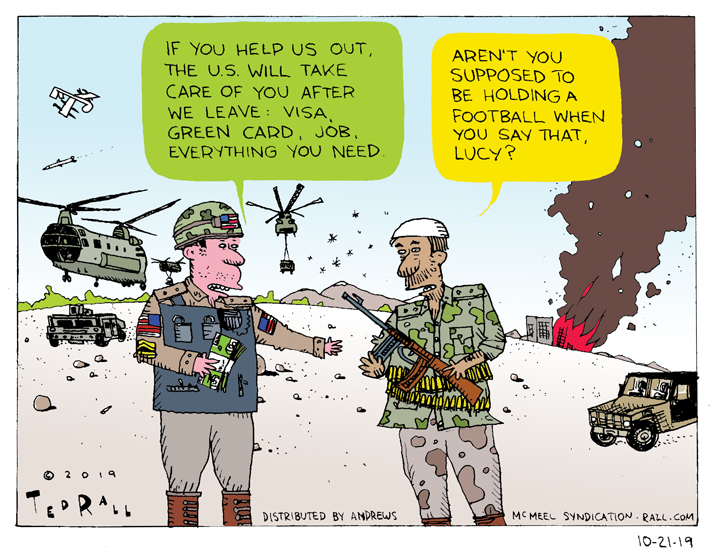 On this episode of The Final Countdown, hosts Angie Wong and Ted Rall discuss a wide range of topics from around the globe, including top U.S. military officers facing Congress over funding to Ukraine and Israel.
On this episode of The Final Countdown, hosts Angie Wong and Ted Rall discuss a wide range of topics from around the globe, including top U.S. military officers facing Congress over funding to Ukraine and Israel.
The Final Countdown – 8/3/23 – Trump Blasts Federal Charges, Presses Forward With 2024 Campaign
The Final Countdown – 7/12/23 – NATO Renews Long-Term Vow to Back Ukraine Against Russia
The Final Countdown – 7/10/23 – Turkey to Join EU in Exchange for Approving Sweden to NATO?
Scott Stantis: Cartoonist for The Chicago Tribune
Erdogan Retains Turkish Presidency While Kosovo Witnesses Upheaval
In the first half hour, the hosts were joined by Conservative commentator and Cohost of Fault Lines Melik Abdul to discuss the debt ceiling deal.
The Final Countdown – 5/22/23 – Ukraine to Receive F-16s After Loss of Bakhmut
Where’s Your Football, Lucy?
President Trump’s order to withdraw American troops who created a buffer zone between Turkey and Kurdish-controlled areas of Iraq was a controversial movie seen as a betrayal of a long-time American ally. But there’s a long history of US forces making extravagant promises to local forces, then withdrawing and leaving them to the wolves.
SYNDICATED COLUMN: What’s With News Media Who Don’t Want to Publish News?

If a pizza shop refused to sell pizza, everyone would say it was run by crazy people.
What does it say about the people who run the news media that they don’t want to report news?
If you read on, you probably expect this lede to be revealed as hyperbole. Sorry, no. I mean it: newspaper editors and TV producers routinely come across delicious slices of news, and then decide not to publish them or put them on the air.
Yet nobody calls them what they are: censors.
Or crazy people.
News businesses constantly refuse to serve news to eager news consumers. Because censorship is normative, it rarely makes the news itself.
This week’s debate over whether to run photos of the body of a 3-year-old boy on a beach, a Syrian refugee boy who drowned off the coast of Turkey, is a revealing exception.
“As the photographs appeared again and again in timelines on Facebook and Twitter, spurred in part by their publication on the websites of major European newspapers, a debate broke out about the ethics of sharing such graphic images of a dead child,” Robert Mackey reported in The New York Times. “There were also disagreements inside newsrooms about whether to publish or even share the images. A number of reporters argued forcefully that it was necessary to confront the public with the human toll of the war in Syria, and the impact of policies that make it difficult for refugees to find asylum in Europe. But many editors were concerned about shocking their readers and wanted to avoid the appearance of trafficking in sensational images for profit.”
Debate? There should be no debate.
Newspapers sell news. When an editor decides whether an item ought to go into her newspaper, she ought to consider one question, and one question only:
Is it news?
If it’s news, it goes in. No matter what.
Clearly, Europe’s refugee crisis is news. Tens of thousands of people, many fleeing civil wars and poverty in north Africa and the Middle East, are escaping to Europe on rickety vessels, some of which founder and sink in the Mediterranean. The European Union can’t come up with a plan to deal with them. It’s a story involving big issues like nativism, xenophobia, racism and a vacuum of political leadership, as well as blowback from American and European foreign interventionism.
Though sentimental and perhaps a big mawkish, the heartbreaking photo of the drowned boy illustrates the human cost of Europe’s failure vis-à-vis the refugee crisis. Which makes it news.
So it should run.
Easy decision, really. So why are editors worried about irrelevant concerns, like whether the photo is “tasteful”?
For some editors, according to the Times, it came down to whether readers could see the boy’s face:
“Many news organizations in the United States decided to publish pictures of the dead child in their print or online editions, but they were divided over whether to show more graphic images of the boy lying in the sand with his face partially visible. The New York Times published a less jarring image that shows a Turkish police officer carrying the child away but conceals his face. Several other newspapers, including The Wall Street Journal and The Baltimore Sun, followed the same course of action.”
Thank you, Editor Nanny, but I’ll take my news the way God intended it: 200 proof, undiluted.
This is yet another case of a tiny good — respect for the dead — causing a big harm.
Hundreds of people, including that Syrian boy, are dying, and dying horribly. Their deaths are totally avoidable. The EU, home to hundreds of millions of people, can easily absorb even a million refugees. The U.S., whose foreign wars are in large part responsible for the crisis, can help subsidize resettlement costs, and invite many of the victims to come here.
Posting the more “jarring” image (which appeared all over the Internet anyway) might help jar the world into taking action. Conversely, not posting it delays action, guaranteeing that more little boys will die.
Surely saving those boys is more important than worrying making readers queasy over their morning cereal — yes, even if some of those readers are kids themselves.
“I understand the argument for running the photo as a way to raise awareness and call attention to the severity of the refugee crisis, and I don’t begrudge outlets that did,” commented Vox media editorial director Max Fisher, “but I ultimately I decided against running it because the child in that photo can’t consent to becoming a symbol.” Does this mean Vox won’t run any images of dead people, ever? Or images of people who don’t consent to being photographed? That’ll make Vox even more boring.
You know what’s worse than taking a chance that kids will see pictures of dead kids? Not taking that chance, so that more kids wind up dead.
(Ted Rall, syndicated writer and the cartoonist for ANewDomain.net, is the author of the new book “Snowden,” the biography of the NSA whistleblower. Want to support independent journalism? You can subscribe to Ted Rall at Beacon.)
COPYRIGHT 2015 TED RALL, DISTRIBUTED BY CREATORS.COM
SYNDICATED COLUMN: 7 Questions You Should Ask About Syria
Lightening-Quick Obama Makes Bush’s “Rush to War” Look Slow and Methodical
Ten years ago, George W. Bush and his henchmen were beginning their war against Iraq. They wanted to invade hours after 9/11. But conning Congress and the public into invading a country that posed no threat to us delayed the invasion until March 2003. This week, as the media celebrates the 50th anniversary of the March on Washington and Martin Luther King’s iconic speech, it is shock- and awe-inspiring to see how far America has come. Where it took a white president a year and a half to pour on enough lies of omission, contextual lapses and leaps of logic to gin up a stupid, illegal war in the Middle East, our black president did it in a week.
Here we go again. A Baathist autocrat is in American crosshairs. The justification: WMDs. Also, he “kills his own people.” Which we haven’t cared about before. But: WMDs.
Ten years ago, the Baathist tyrant of Iraq denied the WMD accusations and invited UN weapons inspectors to verify his claim. Which they did. Because he was telling the truth. But the Bushies didn’t want to wait. No time! Had to invade right away!
And: again. “At this juncture, the belated decision by the regime to grant access to the UN team is too late to be credible,” an Obama official said five days after Syrian troops allegedly fired poison gas into a neighborhood on the outskirts of Damascus, killing over 1000 people.
“Too late”? Really? Assad’s government OKed the inspection less than 48 hours after the UN asked. On a weekend. I have editors who don’t get back to me that quickly. Doesn’t seem like a slow response from a government that doesn’t have diplomatic relations with the U.S. Also, they’re kinda busy fighting a civil war.
Now is a good time to think about some things the American mainstream media is omitting from their coverage — concerns strikingly similar to issues that never got discussed back in 2002 and 2003.
1. “Chemical weapons were used in Syria,” Secretary of State John Kerry says. Probably. But by whom? Maybe the Syrian army, maybe the rebels. Experts tell NPR: “The Free Syrian Army has the experience and perhaps even the launching systems to perpetrate such an attack.” Maybe we should ease off on the cruise missiles before we know which side is guilty.
2. Assuming the attack was launched by the Syrian army, who gave the order to fire? Maybe it’s Assad or his top generals. Assad denies this, calling the West’s accusations “nonsense” and “an insult to common sense.” Which, when you think about it, is true. As Barbara Walters and others who have met the Syrian dictator have found, Assad is not an idiot or a madman. He is a well-educated, intelligent man Why would he brush off Obama’s “red line” about the use of chemical weapons last year? His nation borders Iraq, so it’s not like he needs reminders of what happens when you attract unwanted attention from the U.S. Why would Assad take that chance? His forces are doing well. If the attack came from Assad’s forces, maybe it originated on the initiative of a lower-level officer. Should the U.S. go to war over the possible actions of a mid-ranked army officer who went rogue?
3. “The options that we are considering are not about regime change,” says the White House PR flack. So why is Obama “days away” from a military strike? To “send a message,” in Beltway parlance. But the air war that the attack on Syria is reportedly being modeled after, Clinton’s campaign against Serbia during the 1990s, caused the collapse of the Serbian government. Regional players think, and some hope, that degrading Assad’s military infrastructure could turn the war in favor of the Syrian rebels. If toppling Assad isn’t Obama’s goal, why chance it?
4. When you bomb one side in a civil war — a side that, by the way, might be innocent of the chemical attack — you help their enemies. Assad is bad, but as we saw in post-Saddam Iraq, what follows a dictator can be worse. Syria’s rebel forces include radical Islamists who aren’t very nice guys. They’ve installed Taliban-style Sharia law in the areas they control, issuing bizarre edicts (they’ve outlawed croissants) and carrying out floggings and executions, including the recent whipping and fatal shooting of a 14-year-old boy for making an offhand remark about Mohammed. Obama is already sending them arms and cash. Should we fight their war for them too?
5. Why are chemical weapons considered especially bad? Because the U.S. has moved on to other, more advanced ways to kill people. And because we claim to be exceptional. Paul Waldman of The American Prospect notes: “We want to define our means of warfare as ordinary and any other means as outside the bounds of humane behavior, less for practical advantage than to convince ourselves that our actions are moral and justified.” And, as Dominic Tierney argued in The Atlantic, “Powerful countries like the United States cultivate a taboo against using WMD partly because they have a vast advantage in conventional arms.” If 100,000 people have died in Syria during the last two years, why are these 1000 deaths different?
6. White phosphorus is a chemical weapon that kills people with slow, agonizing efficiency, melting their bodies down to their bones. The U.S. dropped white phosphorus in Iraq, notably in the battle of Fallujah. The U.S. uses depleted uranium bombs in Afghanistan. Those are basically chemical weapons. The U.S. uses non-chemical weapons that shock the world’s conscience, such as cluster bombs that leave brightly colored canisters designed to attract playful children. Assuming the Assad regime is guilty as charged of the horrors in Damascus, why does the U.S. have the moral standing to act as jury and executioner?
7. Why us? Assuming that military action is appropriate in Syria, why is the United States constantly arguing that we should carry it out? Why not France, which has a colonial history there? Or Turkey, which is right next door? Or, for that matter, Papua New Guinea? Why is it always us?
Because our political culture has succumbed to militarism. Which has made us so nuts that we’ve gone from zero to war in a week. Which brings up a quote from the “forgotten MLK,” from 1967: “I knew that I could never again raise my voice against the violence of the oppressed in the ghettos without having first spoken clearly to the greatest purveyor of violence in the world today — my own government.”
Some things never change.
(Ted Rall’s website is tedrall.com. Go there to join the Ted Rall Subscription Service and receive all of Ted’s cartoons and columns by email.)
COPYRIGHT 2013 TED RALL

